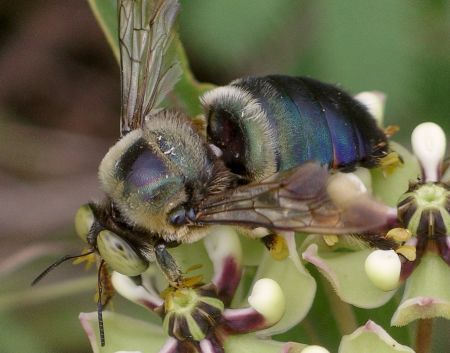by Valerie
July, 2009Eastern Carpenter Bee
When most people think of bees, only the European honey bee and the bumble bee come to mind. These two represent social bees, which maintain colonies or hives, and have a queen. There are far more species of solitary bees, though, and our native fauna has many representatives. The biggest of these is the eastern carpenter bee (Xylocopa virginica). Because of its large size and coloration, this bee is often mistaken for a bumble bee. In bright sunshine, the metallic areas (with color brought out in this photo by an overcast sky) are solid black, and the light hairs on the thorax and top part of the abdomen can be tan to yellow. The big difference between carpenter bees and bumble bees is that the former have bare, shiny abdomens while the latter have thick hair. Here in Austin, bumble bees often do not appear in any numbers until late in the spring, while these carpenter bees start buzzing around flowers much earlier. The reason for the later appearance of the bumble bees is probably that the queens must start their colonies each spring and it takes awhile for the workers to start showing up in gardens. Carpenter bees, as might be expected, excavate holes for their grubs in wood. They rarely occur in such numbers as to weaken beams, but several holes may be in the same vicinity. Males sometimes hover around the females, both at their nests and when they are foraging. The males have white faces while those of the females are black. Large springtime flowers such as prickly poppy and prickly pear cactus are especially attractive to this species. The bees are sometimes covered with pollen from wallowing in the numerous stamens of those blossoms. The individual in the accompanying photo is feeding on antelope horns, a common milkweed in our area. A close look reveals that there are small yellow things attached to the legs of the bee. These are pollen sacs, or pollinia, usually associated with orchids but also found on some milkweeds. The pollinia are rather firmly attached to the flower, but a bee this large can pull them free and then deliver them to another plant. |